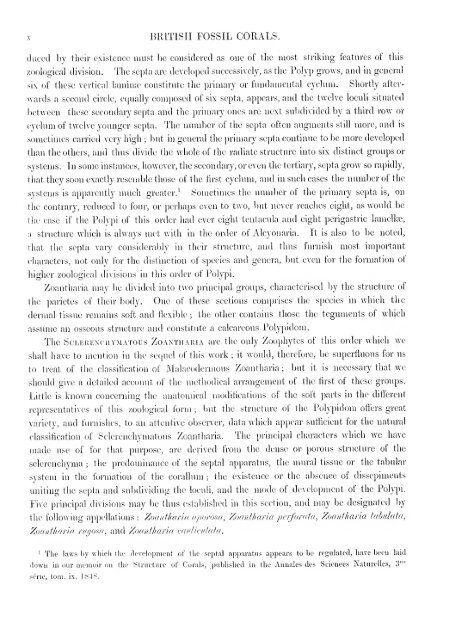A monograph of the British fossil corals - kreidefossilien.de
A monograph of the British fossil corals - kreidefossilien.de
A monograph of the British fossil corals - kreidefossilien.de
Create successful ePaper yourself
Turn your PDF publications into a flip-book with our unique Google optimized e-Paper software.
X<br />
BRITISH FOSSIL CORALS.<br />
duced by <strong>the</strong>ir existence must he consi<strong>de</strong>red as one <strong>of</strong> <strong>the</strong> most striking features <strong>of</strong> this<br />
zoological division. The septa are <strong>de</strong>veloped successively, as <strong>the</strong> Polyp grows, and in general<br />
six <strong>of</strong> <strong>the</strong>se vertical laminae constitute <strong>the</strong> primary or fundamental cyclum. Shortly afterwards<br />
a second circle, equally composed <strong>of</strong> six septa, appears, and <strong>the</strong> twelve locuh situated<br />
between <strong>the</strong>se secondary septa and <strong>the</strong> primary ones are next subdivi<strong>de</strong>d by a third row or<br />
cyclum <strong>of</strong> twelve younger septa. The number <strong>of</strong> <strong>the</strong> septa <strong>of</strong>ten augments still more, and is<br />
sometimes carried very high ; but in general <strong>the</strong> primary septa continue to be more <strong>de</strong>veloped<br />
than <strong>the</strong> o<strong>the</strong>rs, and thus divi<strong>de</strong> <strong>the</strong> whole <strong>of</strong> <strong>the</strong> radiate structure into six distinct groups or<br />
systems. In some instances, however, <strong>the</strong> secondary, or even <strong>the</strong> tertiary, septa grow so rapidly,<br />
that <strong>the</strong>y soon exactly resemble those <strong>of</strong> <strong>the</strong> first<br />
cyclum, and in such cases <strong>the</strong> number <strong>of</strong> <strong>the</strong><br />
systems is appai'cntly much greater.^ Sometimes <strong>the</strong> number <strong>of</strong> <strong>the</strong> primary septa is, on<br />
<strong>the</strong> contrary, reduced to four, or perhaps even to two, but never reaches eight, as would be<br />
<strong>the</strong> case if <strong>the</strong> Polypi <strong>of</strong> this or<strong>de</strong>r had ever eight tentacula and eight perigastric lamellae,<br />
a sti-ucture which is always met with in <strong>the</strong> or<strong>de</strong>r <strong>of</strong> Alcyonaria. It is also to be noted,<br />
that <strong>the</strong> septa vary consi<strong>de</strong>rably in <strong>the</strong>ir structure, and thus furnish most important<br />
characters, not only for <strong>the</strong> distinction <strong>of</strong> species and genera, but even for <strong>the</strong> formation <strong>of</strong><br />
higher zoological divisions in this or<strong>de</strong>r <strong>of</strong> Polypi.<br />
Zoantharia may be divi<strong>de</strong>d into two principal groups, characterised by <strong>the</strong> structure <strong>of</strong><br />
<strong>the</strong> parietes <strong>of</strong> <strong>the</strong>ir body. One <strong>of</strong> <strong>the</strong>se sections comprises <strong>the</strong> species in which <strong>the</strong><br />
<strong>de</strong>rmal tissue remains s<strong>of</strong>t and flexible ; <strong>the</strong> o<strong>the</strong>r contains those <strong>the</strong> teguments <strong>of</strong> which<br />
assume an osseous structure and constitute a calcareous Polypidom.<br />
The ScLERENCHYMATOUS ZoANTHARiA are <strong>the</strong> only Zoophytes <strong>of</strong> this or<strong>de</strong>r which we<br />
shall have to mention in <strong>the</strong> sequel <strong>of</strong> this work ; it would, <strong>the</strong>refore, be superfluous for us<br />
to treat <strong>of</strong> <strong>the</strong> classification <strong>of</strong> Malaco<strong>de</strong>rmous Zoantharia ; but it is necessary that we<br />
should give a <strong>de</strong>tailed accovxnt <strong>of</strong> <strong>the</strong> methodical arrangement <strong>of</strong> <strong>the</strong> first <strong>of</strong> <strong>the</strong>se groups.<br />
Little is known concerning <strong>the</strong> anatomical modifications <strong>of</strong> <strong>the</strong> s<strong>of</strong>t parts in <strong>the</strong> difierent<br />
representatives <strong>of</strong> this zoological form ; but <strong>the</strong> structm-e <strong>of</strong> <strong>the</strong> Polypidom <strong>of</strong>iers great<br />
variety, and furnishes, to an attentive observer, data which appear sufficient for <strong>the</strong> natmal<br />
classification <strong>of</strong> Sclerenchymatous Zoantharia. The principal characters which we have<br />
ma<strong>de</strong> use <strong>of</strong> for that pm-pose, are <strong>de</strong>rived from <strong>the</strong> <strong>de</strong>nse or porous structure <strong>of</strong> <strong>the</strong><br />
sclerenchyma ; <strong>the</strong> predominance <strong>of</strong> <strong>the</strong> septal apparatus, <strong>the</strong> miu-al tissue or <strong>the</strong> tabular<br />
system in <strong>the</strong> formation <strong>of</strong> <strong>the</strong> corallum ; <strong>the</strong> existence or <strong>the</strong> absence <strong>of</strong> dissepiments<br />
uniting <strong>the</strong> septa and subdividing <strong>the</strong> loculi, and <strong>the</strong> mo<strong>de</strong> <strong>of</strong> <strong>de</strong>velopment <strong>of</strong> <strong>the</strong> Polj^^i.<br />
Five principal divisions may be thus established in this section, and may be <strong>de</strong>signated by<br />
<strong>the</strong> following appellations : Zoantharia aporosa, Zoantharia perforata, Zoantharia tabulata,<br />
Zoantharia riir/osa, and Zoantharia caulicidata.<br />
1<br />
The laws by which <strong>the</strong> <strong>de</strong>velopment <strong>of</strong> <strong>the</strong> septal apparatus appears to be regulated, have been laid<br />
down in our memoir on <strong>the</strong> Structure <strong>of</strong> Corals, 'published in <strong>the</strong> Annales <strong>de</strong>s Sciences Naturelles, 3°"<br />
sene, torn, ix, 1848.
















